
Polycrates (r. c. 535-522 BCE) was the tyrant of Samos who established Samian naval supremacy in the eastern Aegean and strove for control of the Aegean Sea and mainland towns of Ionia in the 6th century BCE. Polycrates had a successful career until the Persian Oroetus (r. c. 530-520 BCE) lured him to the mainland and had him crucified.
Ancient Samos
Greek tyrants originally arose in the 7th century BCE from conflict between aristocratic families seeking total authority over the communities. They employed appealing propagandistic policies to gain the favor and regard of the general public. This tactic may also be seen in modern times when dictators use populistic appeals to the lower classes to conceal other heinous crimes. The Greek tyrants were numerous, some of the most worth noting were Cypselus of Corinth (c. 657-627 BCE) and Peisistratus of Athens (c. 600-527 BCE).
The strategic location of Samos was crucial for the rapid generation of wealth by the local elites. The favorable geographical position of the Samos and its surrounding islands endorsed the Samian control of the merchant ships passing by, capturing the majority of the cargo transported from the eastern Mediterranean Sea to the Aegean Sea and the Hellespont. Thus, since the 8th century BCE, the dawn of Archaic Greece, Samians had created a plundering mentality to survive. That lifestyle of plunder was fused with a strong affinity with the goddess Hera, whose stone temple must have been erected after 800 BCE. With its impressive length of 30,5 meters (100 ft), this temple was one of the earliest and biggest temples found in the archaeological records, reflecting Hera's central role in the local community. The construction of a new Hera temple is almost the only other event that can be traced back to the reigns of the pre-Polycratean rulers.
The scene for the tyrant Polycrates' reign is set by the invasion of Cyrus II (c. 600-530 BCE), the king and founder of the Persian Achaemenid Empire. According to Herodotus, when Cyrus looked towards the west, he must have had a significant numerical advantage against Croesus (r. c. 585-546 BCE), the king of Lydia, despite the fact that Croesus had signed a treaty of hospitality and alliance with Sparta. After Cyrus' presence in Lydia was established, it appears that the Greeks dispatched no troops to Sardis, the capital. Cyrus struck in the midst of winter, catching the Lydian army off guard, and planned a fight at the Battle of Thymbra near Sardis in 547 BCE. Croesus was obliged to seek refuge in the citadel, but the city fell within 14 days. When Cyrus entered Sardis, Croesus surrendered and became Cyrus' vassal. As a result, the aspirant Achaemenid king controlled Lydia, a neighboring area of Samos. The western expansion of the Persian ruler forced the Samian elite to change their economic policy and redirect their plundering assaults toward the west.
Rise to Power
Piracy was rife when the infamous Samian tyrant Polycrates, the son of Aeaces, grew up, and this may have inspired the blooming tales of a Samian thalassocracy – a naval dominion to arise. The history of Polycrates is mainly attested by Herodotus (c. 484-425/413 BCE), the Greek historian from Halicarnassus. Although Polycrates is mentioned in other primary sources such as Aristotle (384-322 BCE), the most concluded and remarkably detailed version comes from Herodotus.
Polycrates' ancestors are not clearly established, and no transparent information exists on them. Two names appear before Polycrates: Syloson, who ruled Samos as a tyrant c. 590 BCE, and Aeaces, the probable father of Polycrates. Polycrates was probably born in the 570s BCE, followed by his two brothers Pantagnotos and Syloson. The earliest phase of Polycrates' reign was shared by his two brothers until he had Pantagnotos executed and Syloson exiled to Persia. According to the Bithynian author Polyaenus (c. 2nd century BCE), the tyrant seized power during the grand festival outside of the city walls, dedicated to Hera, the island's most celebrated deity. The works of Asius, the 6th-century BCE Samian poet, and Duris (c. 350 to c. 281 BCE), the Hellenistic ruler of Samos, support Polyaenus' description.
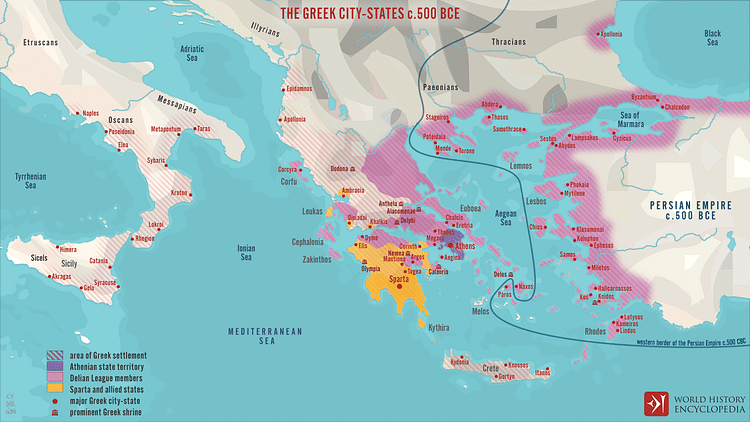
Polycrates' career seems to have followed a similar pattern as the rest of the Greek tyrants. He probably started his coup d'etat by capturing the Samian acropolis, located in the center of the ancient city. Furthermore, the brothers were supported by many citizens who could afford a panoply; it is possible that these men were from Polycrates' immediate family or sympotic group. Their small number could imply there was no serious opposition to the coup, so the bulk of the aristocrats or the mass of the demos (Greek citizens) or both were either apathetic or positively in favor. A preserved passage from Duris' Samian Annals describes how Polycrates arranged for the mothers of those who died in the war to be cared for by Samos' wealthiest people. This extract could probably indicate propaganda to reconcile the public.
Economy & Government
Polycrates must have been a popular man, but those who opposed his reign, typically members of the old aristocracy, were either sent into exile or voluntarily left the island. The most famous was the philosopher Pythagoras (c. 570-495 BCE), who went to Egypt and southern Italy, while others settled in Dicaearchia (Puteoli) near Naples. The change to the Lydo-Milesian coin standard popular among traders facilitated easier exchange in Persian territories from c. 525 BCE. Polycrates' introduction of exotic animals has often been seen as evidence of an attempt to bolster the economy and maybe to please the aristocrats that surrounded him. The variety of the imports justifies Polycrates' well-deserved sailing reputation. The years c. 570-530 BCE also saw the creation of the most exceptional and well-known Samian sculptures. Since Polycrates was born and reigned during these decades, both ancient and modern scholars associated him with the arts, although, there is no evidence to support such claims.
A passage of Anacreon (c. 582- 485 BCE) suggests a Samian attempt to influence the city of Magnesia on the Meander through propaganda, which promotes the evidence for an invasion. As the Persians were too powerful on the mainland, Polycrates could not have permanently occupied Ionian cities or linked them to Samos in a tribute alliance. Thus, Greeks living near the sea did not establish colonies to obtain supplies of grain and other commodities; they would have frequently captured ships instead. The theory of looting and plundering everybody equally may be the most accurate description of the thalassocracy, and many residents would have benefitted from plunder via employment in the fleet. Nevertheless, Herodotus says that the islanders submitted to Cyrus.
Foreign Policy
At first, Polycrates merely exploited the geopolitical situation and had the support of Lygdamis (r. c. 546-524 BCE), the tyrant of Naxos, who had been put in power by Peisistratus sometime after 546 BCE. Additionally, an alliance between the Egyptian pharaoh Amasis II (r. 570-526 BCE) and Polycrates is documented by Herodotus. Fearing a Persian attack, Amasis developed a naval strategy, built a navy, hired Carian and Greek mercenaries, conquered Cyprus, and allied himself with Polycrates. Amasis also gave Polycrates a large sum of money, which the Samian used to build 100 ships, each with 50 rowers and ten archers. This contribution could have cost approximately eight tons of silver per year.
The fleet of Polycrates, which was most likely composed, at least in part, of a special design known as the samaina exemplifies how the penteconter underwent several innovations in the Archaic period. During the 6th century BCE, changes to the penteconter's design were made in the Aegean to make it a better vessel for transporting goods and soldiers, as well as a warship. Due to the threat posed by the Persian expansion in the 540s BCE, it is plausible that a coastal polis (city-state) like Samos maintained a penteconter fleet regardless of the expense. Plutarch (c. 45-50 CE to c. 120-125 CE) says that Polycrates commissioned a special type of ship, the samaina. The samaina was supposed to be bigger and more spacious than the ordinary two-level penteconter. It was both decked and swift and stable enough for open-sea excursions. Greek naval warfare at the time was gradually shifting away from the archaic method of boarding the enemy ships and fighting hand-to-hand or overpowering the opponent with missile volleys.
After the death of Cyrus in 530 BCE, Polycrates decided to switch sides and join the new Persian king Cambyses II (r. 530-522 BCE). When Cambyses purchased the formidable Phoenician navy in the 520s BCE, Samian piracy became limited to the Cyclades' poorer cities. Thus, when the loot from the sailing ventures stopped flowing, the Samian aristocracy saw an opportunity to destabilize the tyrant. As the Persian influence increased towards the west, it was no longer safe not to be Amasis' enemy, and so Polycrates dispatched 40 ships to aid Cambyses' invasion of Egypt. The dispute with Amasis may have hampered trade at Naucratis, but Cambyses' conquest of Egypt would put things right for the Samian. It must be noted that according to the ancient sources the admiral of the Egyptian navy also changed sides, so it is possible that Cambyses prepared his Egyptian expedition by bribing away Amasis' naval allies.
The naval attack was also a chance for Polycrates to get rid of disgruntled residents by loading the ships with them. Their relatively gentle, or at least covert, removal suggests that the majority of them were influential individuals. Their removal, however, had far-reaching implications, as they made their way to the Peloponnese and convinced Sparta and Corinth to prepare an expedition against Polycrates. Two possible reasons can be provided for Sparta's involvement: revenge for the theft of Spartan gifts or the repaying of a debt of gratitude, which scholars identified as an act of negative reciprocity. Corinth's involvement can be traced back to the memory of how Samos had once interfered with a plan of its ruler, Periander (d. c. 587 BCE), to punish Corcyra, a Corinthian colony. The interaction between Sparta and the Samian nobles supplied the impetus for the Spartans' first-ever Aegean voyage. An early triumph for them and the Corinthians was followed by a 40-day siege of the city that proved unsuccessful. The Peloponnesian intervention made it obvious that Samian piracy in the Cyclades would no longer be tolerated.
The Death of a Tyrant
In March 522 BCE, civil war broke out in the Persian Empire. During the summer, Polycrates was invited by the satrap of Lydia, Oroetus, to come to Sardes to provide him with gold to continue his ventures. According to Herodotus, Polycrates' daughter had a terrible nightmare, in which she saw how her father was washed by the god Zeus and anointed by the Sun.
And Polycrates hanging in the air fulfilled his daughter's vision in every detail; for he was washed by Zeus when it rained, and he was anointed by Helios as he exuded sweat from his body. (Histories 3.125.4.)
When the chaos in the Persian Empire came to an end, Darius I (r. 522-486 BCE) restored order by executing Oroetus and conquering Samos. Syloson, the exiled brother of Polycrates, had met Darius in Egypt and gifted him a red cloak when the king was one of Cambyses' guards. Now that Darius was king, Syloson requested to return to Samos without bloodshed, and he governed Samos as a vassal ruler on behalf of the Achaemenid Persian Empire.
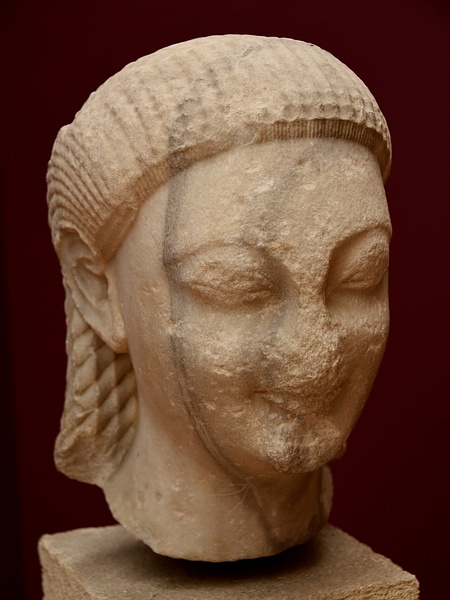
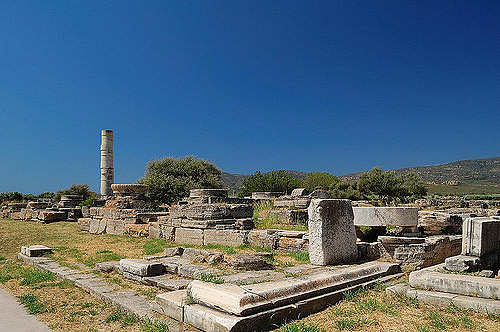

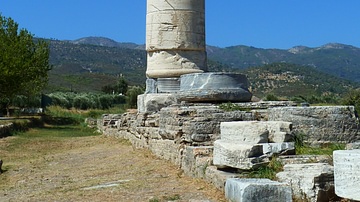
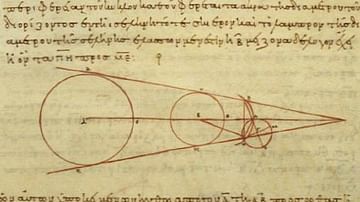
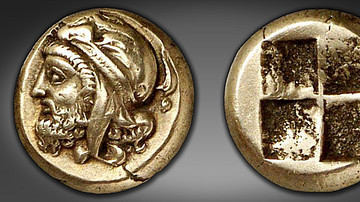
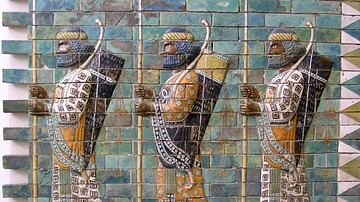
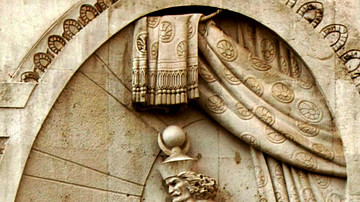
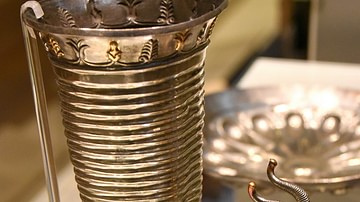
![Quaestiunculae Lysiacae, [Oration Against Aeschines, Polycrates and Andocides].: Progr. (English and Latin Edition)](https://m.media-amazon.com/images/I/51RlFSyKhzL._SL160_.jpg)



